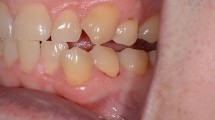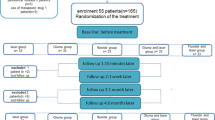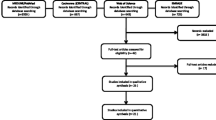Abstract
Objective
Reports indicate Gluma and Duraphat are commonly used in-office agents to treat hypersensitive teeth. Considering this, the aim of this paper is to compare Gluma and Duraphat using a randomized controlled trial, meta-analysis collating evidences from previous studies and trial sequential analysis.
Materials and methods
Thirty-eight participants were randomized. Hypersensitivity and visual analog scale (VAS) scores were recorded at baseline, 5 min and 7 days. Oral health-related quality of life (OHIP) questionnaire was administered at baseline and 7 days. Statistical analysis was performed to identify significant differences between the variables. For the meta-analysis, electronic data bases were searched and eligible data was extracted and analysed using RevMan 5.0. Trial sequential analysis was performed using O’Brien-Fleming boundary approach for the primary outcome.
Results
Both agents caused significant reduction in hypersensitivity and VAS score at 5 min and 7 days in the randomized trial with no superiority. The quality of life significantly improved in patients treated with both the agents. Four studies including the present trial in meta-analysis and trial sequential analysis indicated that Gluma produced significant reduction in VAS scores at 7 days.
Conclusion
Gluma produces significant reduction in hypersensitivity at 7 days post treatment compared with Duraphat. There is definite lack of evidence on the long-term effect of these agents.
Clinical relevance
This paper provides strong evidence on the use of Gluma for hypersensitive teeth. This also is a way forward to future research on long-term effects, adverse effects and cost-effectiveness studies.






Similar content being viewed by others
References
Miglani S, Aggarwal V, Ahuja B (2010) Dentin hypersensitivity: recent trends in management. J Conserv Dent 13(4):218–224
West N, Seong J, Davies M (2014) Dentine hypersensitivity. Monogr Oral Sci 25:108–122. https://doi.org/10.1159/000360749 Review
Cartwright RB (2014) Dentinal hypersensitivity: a narrative review. Community Dent Health 31(1):15–20 Review
Gillam DG, Orchardson R (2006) Advances in the treatment of root dentin sensitivity: mechanisms and treatment principles. Endod Topics 13:13–33
Rösing CK, Fiorini T, Liberman DN, Cavagni J (2009) Dentine hypersensitivity: analysis of self-care products. Braz Oral Res 23(Suppl 1):56–63 Review
Kopycka-Kedzierawski DT, Meyerowitz C, Litaker MS, Chonowski S, Heft MW, Gordan VV, Yardic RL, Madden TE, Reyes SC, Gilbert GH, National Dental PBRN Collaborative Group (2017) Management of Dentin Hypersensitivity by National Dental Practice-Based Research Network practitioners: results from a questionnaire administered prior to initiation of a clinical study on this topic. BMC Oral Health 17(1):41. https://doi.org/10.1186/s12903-017-0334-0
Kopycka-Kedzierawski DT, Meyerowitz C, Litaker MS, Heft MW, Tasgaonkar N, Day MR, Porter-Williams A, Gordan VV, Yardic RL, Lawhorn TM, Gilbert GH, National Dental PBRN Collaborative Group (2017) Management of dentin hypersensitivity by practitioners in the National Dental Practice-Based Research Network. J Am Dent Assoc 148(10):728–736
Cunha-Cruz J, Wataha JC, Zhou L, Manning W, Trantow M, Bettendorf MM, Heaton LJ, Berg J (2010) Treating dentin hypersensitivity: therapeutic choices made by dentists of the northwest PRECEDENT network. J Am Dent Assoc 141:1097–1105
Arends J, Duschner H, Ruben JL (1997) Penetration of varnishes into demineralized root dentine in vitro. Caries Res 31(3):201–205
Schüpbach P, Lutz F, Finger WJ (1997) Closing of dentinal tubules by Gluma® desensitizer. Eur J Oral Sci 105(5 Pt 1):414–421
Ozen T, Orhan K, Avsever H, Tunca YM, Ulker AE, Akyol M (2009) Dentin hypersensitivity: a randomized clinical comparison of three different agents in a short-term treatment period. Oper Dent 34(4):392–398
Olusile AO, Bamise CT, Oginni AO, Dosumu OO (2008) Short-term clinical evaluation of four desensitizing agents. J Contemp Dent Pract 9(1):22–29
Mehmood Z, Shah JA, Javed MU, Manzoor MA, Asghar I, Saeed MH (2011) Efficacy of Gluma desensitizer™ and Duraphat™ in relieving dentinal hypersensivity in non-carious cervical lesions. Pak Oral Dental J 31(1):183
General Assembly of the World Medical Association (2014) World Medical Association Declaration of Helsinki: ethical principles for medical research involving human subjects. J Am Coll Dent 81(3):14–18
Moher D, Hopewell S, Schulz KF, Montori V, Gøtzsche PC, Devereaux PJ, Elbourne D, Egger M, Altman DG, CONSORT (2012) CONSORT 2010 explanation and elaboration: updated guidelines for reporting parallel group randomised trials. Int J Surg 10(1):28–55
Canadian Advisory Board on Dentin Hypersensitivity (2003) Consensus-based recommendations for the diagnosis and management of dentin hypersensitivity. J Can Dent Assoc 69(4):221–226 Review
Gillam DG (2013) Current diagnosis of dentin hypersensitivity in the dental office: an overview. Clin Oral Investig 17(Suppl 1):S21–S29. https://doi.org/10.1007/s00784-012-0911-1 Review
Holland GR, Narhi MN, Addy M, Gangarosa L, Orchardson R (1997) Guidelines for the design and conduct of clinical trials on dentine hypersensitivity. J Clin Periodontol 24(11):808–813
Higgins JPT, Green S (eds) Cochrane handbook for systematic reviews of interventions. 5.1.0 edition. Available from http://www.cochranehandbook.org/. Accessed 28 Sep 2017
Moher D, Liberati A, Tetzlaff J, Altman DG, The PRISMA Group (2009) Preferred reporting items for systematic reviews and meta-analyses: the PRISMA statement. J Clin Epidemiol 62:1006–1012
Sridharan K, Sivaramakrishnan G (2017) Vasoactive agents for hepatorenal syndrome: a mixed treatment comparison network meta-analysis and trial sequential analysis of randomized clinical trials. J Gen Intern Med 33:97–102. https://doi.org/10.1007/s11606-017-4178-8
Gupta U, Verma M (2013) Placebo in clinical trials. Perspect Clin Res 4(1):49–52
Kannan S, Gowri S (2015) Visual analog scale: verify appropriate statistics. Perspectives in Clinical Research 6(2):120. https://doi.org/10.4103/2229-3485.154020
Williamson A, Hoggart B (2005) Pain: a review of three commonly used pain rating scales. J Clin Nurs 14(7):798–804
Bekes K, John MT, Schaller HG, Hirsch C (2009) Oral health-related quality of life in patients seeking care for dentin hypersensitivity. J Oral Rehabil 36(1):45–51
Lima TC, Vieira-Barbosa NM, Grasielle de Sá Azevedo C, de Matos FR, Douglas de Oliveira DW, de Oliveira ES, Ramos-Jorge ML, Gonçalves PF, Flecha OD (2017) Oral health-related quality of life before and after treatment of dentin hypersensitivity with cyanoacrylate and laser. J Periodontol 88(2):166–172
Lin PY, Cheng YW, Chu CY, Chien KL, Lin CP, Tu YK (2013 Jan) In-office treatment for dentin hypersensitivity: a systematic review and network meta-analysis. J Clin Periodontol 40(1):53–64
West NX, Seong J, Davies M (2015) Management of dentine hypersensitivity: efficacy of professionally and self-administered agents. J Clin Periodontol 42(Suppl 16):S256–S302. https://doi.org/10.1111/jcpe.12336 Review
Author information
Authors and Affiliations
Corresponding author
Ethics declarations
Conflict of interest
The authors declare that they have no conflict of interest.
Ethical approval
All procedures performed in studies involving human participants were in accordance with the ethical standards of the institutional and/or national research committee and with the 1964 Helsinki declaration and its later amendments or comparable ethical standards.
Informed consent
Informed consent was obtained from all individual participants included in the study.
Rights and permissions
About this article
Cite this article
Sivaramakrishnan, G., Sridharan, K. Fluoride varnish versus glutaraldehyde for hypersensitive teeth: a randomized controlled trial, meta-analysis and trial sequential analysis. Clin Oral Invest 23, 209–220 (2019). https://doi.org/10.1007/s00784-018-2428-8
Received:
Accepted:
Published:
Issue Date:
DOI: https://doi.org/10.1007/s00784-018-2428-8




